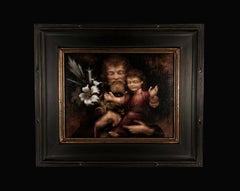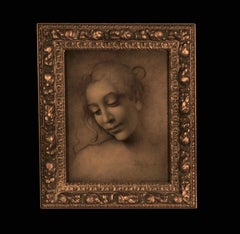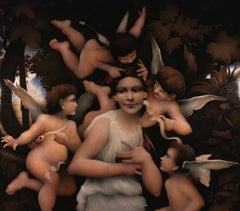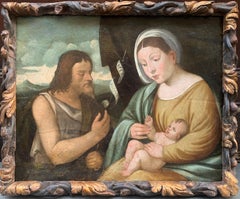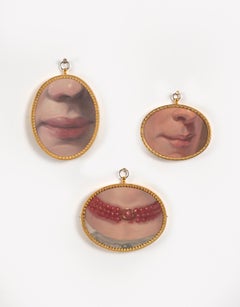Justas Varpucanskis Paintings
to
5
1
2
Overall Width
to
Overall Height
to
8
2
4
3
1
2
2
1
1
8
7
4
4
4
2
8
Sancte Ioseph
Located in Mokena, IL
Sancte Ioseph, 2023
Oil on Panel with Frame, 17.5 x 20.5 inches
With luminous depths, “Sancte Ioseph” presents an intimate portrayal of St. Joseph gently holding the Christ child, ...
Category
21st Century and Contemporary Contemporary Figurative Paintings
Materials
Oil
Eli
Located in Mokena, IL
Eli, 2020
Oil on Panel with Carved and Gilded Frame, 11.5 x 13.5 inches
An embodiment of Renaissance portraiture, Varpucanskis’s “Eli” is distinguished by its gentle charm and mat...
Category
21st Century and Contemporary Renaissance Portrait Paintings
Materials
Gold Leaf
$17,500
Ritratto con paesaggio
Located in Mokena, IL
Riratto con Paesaggio, 2019
Oil on Panel with Frame, 11 x 14 inches
A quiet and contemplative portrait painting, "Ritratto con Paesaggio", by Justas Varpucanskis, presents a sooth...
Category
21st Century and Contemporary Renaissance Portrait Paintings
Materials
Oil
Ritratto dell'uomo
Located in Mokena, IL
Riratto dell’uomo, 2019
Oil on Panel with Gilded Frame, 14 x 14 inches
Set against a penetrating black background, Justas Varpucanskis’s “Ritratto dell’uomo”’ emerges with a shrou...
Category
21st Century and Contemporary Contemporary Portrait Paintings
Materials
Oil
Coronation of Venus
Located in Mokena, IL
Coronation of Venus, 2021
Oil on Panel with 24k Gold Water-Gilded Frame, 114 x 78 inches
“Coronation of Venus,” an ornamentally enriching piece from the studio of Justas and Vilius...
Category
21st Century and Contemporary Renaissance Figurative Paintings
Materials
Gold Leaf
School of Stoics
Located in Mokena, IL
The School of Stoics brings the viewer into an airy evening discussion at an agora overlooking the Aegean Sea. Amidst the silent water and grained marble, a group of stoics debate logic, reason, and nature. Agreement and disagreement prevail in the noble gestures of their bodies. Soon you see an individual's gaze directed towards you, raising their hand, calling you to join the conversation.
Technical:
53” x 39”. Tempera on panel with 24k gold water-gilded frame. Painting and frame produced by artists Justas and Vilius Varpucanskis. This piece utilizes the "rules of craftsmanship" as outlined in Cenino Cennini's Il Libro dell'Arte. 21st century contemporary artwork that employs techniques, philosophy, and visual language of the Italian High Renaissance...
Category
21st Century and Contemporary Renaissance Figurative Paintings
Materials
Gold Leaf
Pieta
Located in Mokena, IL
Pieta, 2019
Oil on Panel with Dutch Ripple Frame, 9 x 12 inches
A whispering portrayal of spiritual sorrow, Justas Varpucanskis’s “Pieta” present...
Category
21st Century and Contemporary Baroque Figurative Paintings
Materials
Oil
Our Lady of Mercy
Located in Mokena, IL
Our Lady of Mercy, 2021
Oil on Panel with Carved and Gilded Frame, 8 x 14 inches
A work of spiritual devotion, Justas Varpucanskis’s “Our Lady of...
Category
21st Century and Contemporary Renaissance Figurative Paintings
Materials
Gold Leaf
Related Items
Venice. XVI century. Madonna with child with St. John. Attrib. Marco Bello.
Located in Firenze, IT
Sacred Conversation: Madonna with child with St. John with idealized landscape background with mountains.
Early XVI century.
Oil on wooden panel of Venetian conifers.
Marco Bello, attributed. (Venezia, 1470 - 1523, Udine), pupil and follower of Giovanni Bellini.
Venetian school.
Madonna with child with St. John with idealized landscape background with mountains.
Dimentions: 57cm x 68cm x 6cm
Beautiful late Renaissance frame...
Category
16th Century Renaissance Figurative Paintings
Materials
Wood Panel, Oil
$4,157
H 22.45 in W 26.78 in D 2.37 in
They after Batoni and Hodges
By Derrick Guild
Located in London, GB
Dimensions variable: medium oval 7.5cm x 9.5cm; large oval 9cm x 11cm.
Derrick Guild is a Scottish artist whose paintings fragment Old Master works to explore the social fabric bene...
Category
2010s Contemporary Portrait Paintings
Materials
Linen, Oil
Circle of Amico Aspertini, The meeting of Anna and Gioacchino
Located in Tricase, IT
Circle of Amico Aspertini
Oil on panel, 59x31 cm.
Provenance: Asta Pandolfini 8 marzo 2023 lot. 47.
He was born in Bologna to a family of painters (including Giovanni Antonio Asperti...
Category
16th Century Renaissance Figurative Paintings
Materials
Oil, Board
$3,546
H 12.21 in W 23.23 in D 1.97 in
Oil Portrait of a Victorian Lady, c. 1850
Located in Chicago, IL
Painted in the 19th century, this exquisite miniature portrait wonderfully exemplifies realism in traditional oil painting. The small artwork is painted in the conventional portraiture style of the Old Masters, and achieves soft realism with fine brushwork and a subdued, neutral palette. The half length portrait depicts a fine Victorian woman dressed in all black with a delicate lace collar and bonnet. She wears a ruby broach...
Category
Mid-19th Century Old Masters More Art
Materials
Oil
I Used to Dream - Original Figurative Vibrant Mixed Media Painting on Canvas
Located in Los Angeles, CA
Rooted in introspection and emotional nuance, Xenia Gray’s figurative mixed media works capture the quiet tension between solitude and connection. Her paintings often depict the huma...
Category
2010s Contemporary Figurative Paintings
Materials
Canvas, Charcoal, Oil, Acrylic
"Marilyn Monroe and ocean blue" ( semi-abstract oil painting of woman on paper)
Located in VÉNISSIEUX, FR
This artwork "Marilyn Monroe and ocean blue" is a dynamic exploration of the human form, using bold brushstrokes and vibrant colors to convey movement and emotion.
The piece featur...
Category
2010s Contemporary Figurative Paintings
Materials
Paper, Oil
$148 Sale Price
72% Off
H 11.7 in W 8.27 in D 0.04 in
Saint Anthony the Abbot in a Natural Landscape - Flemish School
Located in Firenze, IT
Saint Anthony The Abbot In A Natural Landscape. Flemish School, Late 16th - Early 17th Century
Technique: Oil on panel
Period: late 16th - Early 17th Century
School: Flemish
Dimensi...
Category
Early 17th Century Renaissance Figurative Paintings
Materials
Oil
$1,773 Sale Price
40% Off
H 13.23 in Dm 13.23 in
Italian Renaissance Gentleman Portrait of a Tailor Antique Oil Painting
Located in Cirencester, Gloucestershire
The Tailor
Continental School, 19th century
after the earlier Renaissance work by Giovanni Battista Moroni (16th century).
oil on canvas laid over board, framed
Framed: 16 x 12 inch...
Category
19th Century Renaissance Portrait Paintings
Materials
Oil
$966 Sale Price
30% Off
H 16 in W 12 in
Portrait of a Lady in White Chemise, Russet & Blue Drapery c.1695, Oil Painting
By Harman Verelst
Located in London, GB
This lavish portrait, painted circa 1695, is an exquisite example of the type of portrait in vogue during the last quarter of the seventeenth century. It is evident that the artist ...
Category
17th Century Old Masters Portrait Paintings
Materials
Canvas, Oil
$7,996
H 29.14 in W 24.41 in D 1.58 in
Circa 1500 Italian Renaissance Oil Painting on Copper St. Francis of Assisi
Located in Cirencester, Gloucestershire
St. Francis of Assisi
Italian School, circa 1500
oil paint on copper, unframed
copper: 6.75 x 10 inches
provenance: private collection, Loire Valley, France
condition: for a work tha...
Category
15th Century and Earlier Renaissance Figurative Paintings
Materials
Copper
$4,282 Sale Price
30% Off
H 6.75 in W 10 in
Portrait of a Lady in Green Dress & Pearl Jewellery c.1660 Painting John Wright
By John Michael Wright
Located in London, GB
In this exquisite work, painted around the time of the Great Fire of London in 1666, a beautiful young woman is wearing a green dress over a white chemise and a russet-coloured scarf...
Category
17th Century Old Masters Portrait Paintings
Materials
Canvas, Oil
$14,558
H 39.38 in W 33.47 in D 3.15 in
18th Century French Oil Painting on Copper Portrait of Noble Lady
Located in Cirencester, Gloucestershire
Portrait of a Noble Lady
French School, early 1700's period
oil painting on copper, unframed
copper: 5 x 3 inches
condition: very good, minor paint fading and deteriation.
provenanc...
Category
Early 18th Century Renaissance Figurative Paintings
Materials
Copper
$736 Sale Price
30% Off
H 5 in W 3 in
